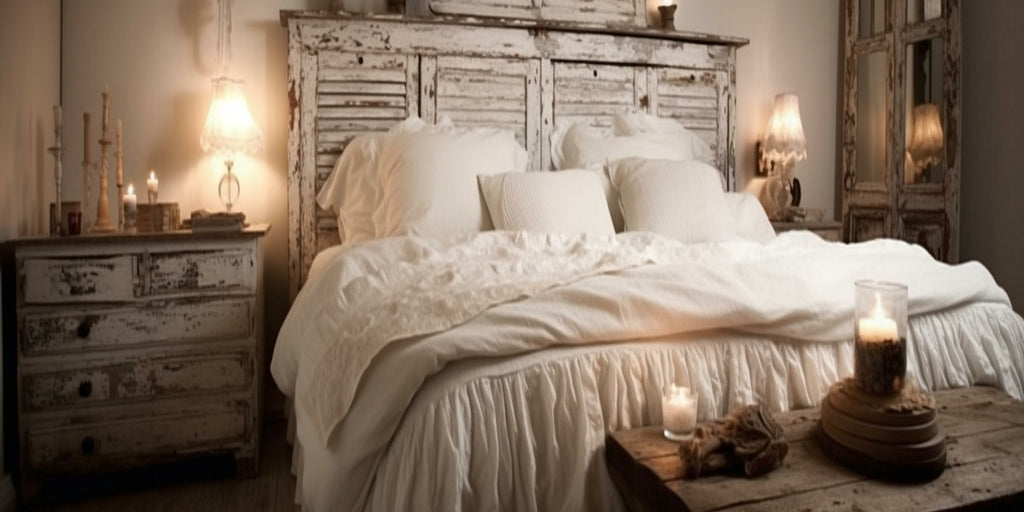
Distressed Design

Love that nostalgic feeling and want to incorporate it into your interior design? You’re not alone. Vintage and distressed design has enjoyed some level of popularity for many decades. The resurgence of farmhouse style about ten years ago started a new trend toward vintage design that has been present ever since.
The hottest designs today are mashups of favorite styles with a touch of rustic. Blending elegance and rusticity can be a challenge, but one many designers are happy to take on. Here’s some of the best ways to get some distressed design in your spaces.

Distressed Defined
The distressed effect in interior design involves intentionally creating a worn, aged, or weathered appearance in furniture, walls, or other design elements to add character, warmth, and a sense of history to a space.
Some of the most popular interior design styles have distressing at their core. Anything that aims to achieve a rustic, natural, or vintage look can benefit from some distressed elements. cottagecore, modern farmhouse, industrial, steampunk, art deco, granny chic, and more are all well-loved styles that incorporate distressing in one form or another.

Incorporating Distressing
A little goes a long way when it comes to distressing. Too much and the design can become eclectic, too little and it gets lost. Here are some excellent ways to achieve the perfect amount of distressing in any style.

Furniture
Use distressed furniture pieces such as tables, chairs, or cabinets. You can either buy pre-distressed furniture or distress them yourself using techniques like sanding, scraping, or applying paint and then distressing it with sandpaper to reveal layers beneath.

Walls
Create a distressed effect on walls using techniques like faux painting, whitewashing, or applying textured wallpaper that mimics an aged appearance. You can also use techniques like rag rolling or sponging with different paint colors to create a weathered look.

Flooring
Distressed wood flooring or tiles can add a rustic and aged appearance to a room. These materials often come with natural distressing, or you can achieve the effect by distressing the flooring yourself using techniques like sanding or using a wire brush.

Accessories
Incorporate distressed accessories like mirrors, frames, or decorative items to add character to the space. Items with chipped paint, worn finishes, or rusted metal can contribute to the distressed aesthetic.

Textiles
Use distressed fabrics for upholstery, curtains, or throw pillows. Fabrics with frayed edges, faded colors, or a worn appearance can add to the overall distressed look.

Mix and match
Combining distressed elements with more modern or sleek pieces can create an eclectic and visually interesting design. For example, pairing a distressed wooden table with contemporary chairs can add contrast and depth to the room.

DIY techniques
Experiment with different distressing techniques like dry brushing, crackle paint, or using a hammer and chain to create dents or marks on furniture or surfaces.Patina finishes
Utilize patina finishes on metal surfaces to create an aged and weathered appearance. This technique involves applying chemicals or solutions to metals to create oxidation and achieve an antique look.

Patinized Tin Tile
One of the most accessible elements to get a distressed patina is tin ceiling tile. Like distressing, patina is a thin layer that forms on the surface of metals. It is also called tarnish or oxidation. Many people polish away patina, but others value it for the vintage look it offers.American Tin Ceilings’ colors with patina are created by hand by our artisans who apply additional color to a powder coated tin tile. Then they remove some of the paint in a way that makes the tin tile look as if it has a natural patina.
This process adds an instant vintage quality that helps you achieve your rustic vision with ease.
Distressed Tin Tile
Already rife with history, tin tile is the perfect addition when you want to add some rusticity to a design. The vintage-inspired patterns and colors add the luxury and weight of a matured material. Distressing only amplifies that.
At American Tin Ceilings, artisans hand-apply color on top of the powder coated tin panel and carefully rub part of it off to let the metallic color underneath show through. The result is a distressed or historic tin tile look.
One of the most popular choices for distressed designs is the distressed white tin tile. Though many colors are available, the white tile with metal showing through is by far the most sought after. It has a clean, light look that makes it a perfect shoe-in for contemporary rustic designs. Here’s a closer look.
Find the perfect touch of distressed tin tile to add to your home design.



